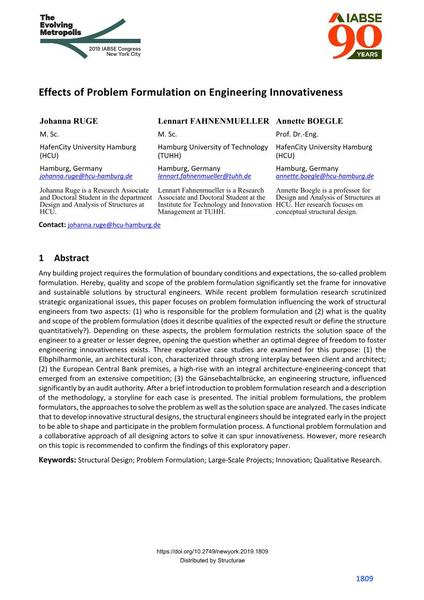Effects of Problem Formulation on Engineering Innovativeness

|
|
|||||||||||
Bibliographic Details
| Author(s): |
Johanna Ruge
(HafenCity University Hamburg (HCU))
Lennart Fahnenmueller (Hamburg University of Technology (TUHH)) Annette Bögle (HafenCity University Hamburg (HCU)) |
||||
|---|---|---|---|---|---|
| Medium: | conference paper | ||||
| Language(s): | English | ||||
| Conference: | IABSE Congress: The Evolving Metropolis, New York, NY, USA, 4-6 September 2019 | ||||
| Published in: | The Evolving Metropolis | ||||
|
|||||
| Page(s): | 1809-1814 | ||||
| Total no. of pages: | 6 | ||||
| DOI: | 10.2749/newyork.2019.1809 | ||||
| Abstract: |
Any building project requires the formulation of boundary conditions and expectations, the so-called problem formulation. Hereby, quality and scope of the problem formulation significantly set the frame for innovative and sustainable solutions by structural engineers. While recent problem formulation research scrutinized strategic organizational issues, this paper focuses on problem formulation influencing the work of structural engineers from two aspects: (1) who is responsible for the problem formulation and (2) what is the quality and scope of the problem formulation (does it describe qualities of the expected result or define the structure quantitatively?). Depending on these aspects, the problem formulation restricts the solution space of the engineer to a greater or lesser degree, opening the question whether an optimal degree of freedom to foster engineering innovativeness exists. Three explorative case studies are examined for this purpose: (1) the Elbphilharmonie, an architectural icon, characterized through strong interplay between client and architect; (2) the European Central Bank premises, a high-rise with an integral architecture-engineering-concept that emerged from an extensive competition; (3) the Gänsebachtalbrücke, an engineering structure, influenced significantly by an audit authority. After a brief introduction to problem formulation research and a description of the methodology, a storyline for each case is presented. The initial problem formulations, the problem formulators, the approaches to solve the problem as well as the solution space are analyzed. The cases indicate that to develop innovative structural designs, the structural engineers should be integrated early in the project to be able to shape and participate in the problem formulation process. A functional problem formulation and a collaborative approach of all designing actors to solve it can spur innovativeness. However, more research on this topic is recommended to confirm the findings of this exploratory paper. |
||||
| Keywords: |
structural design innovation Problem Formulation Large-Scale Projects Qualitative Research
|
||||
